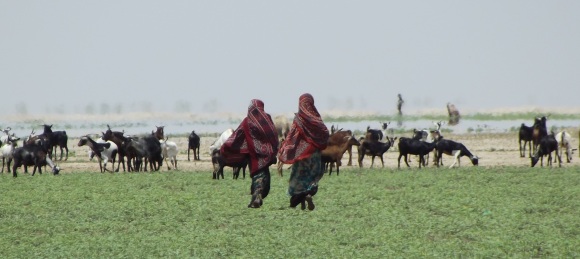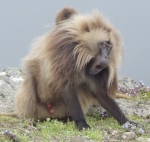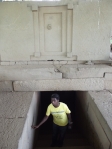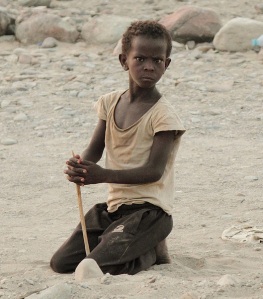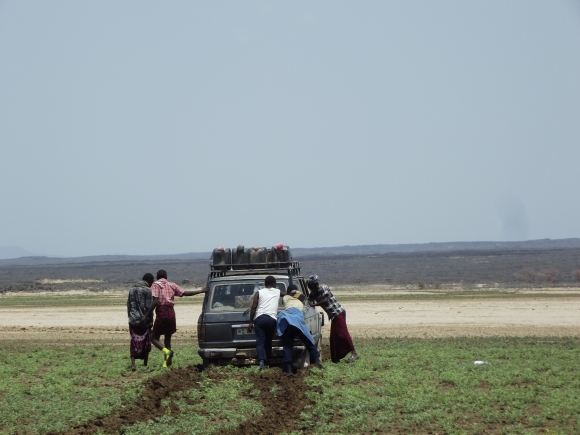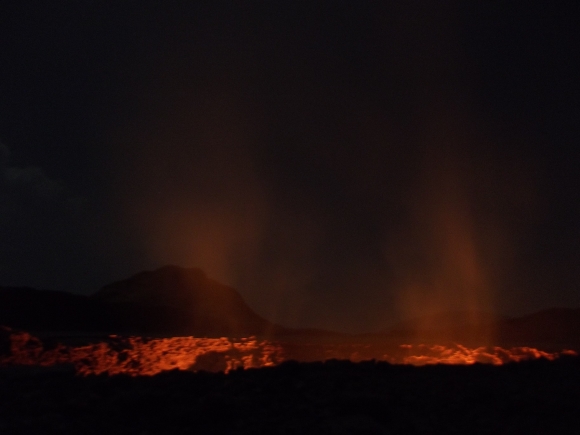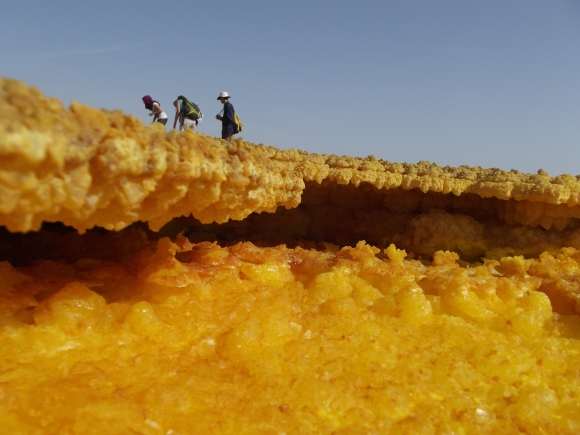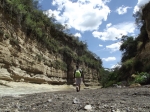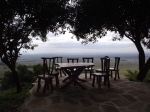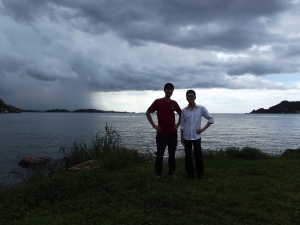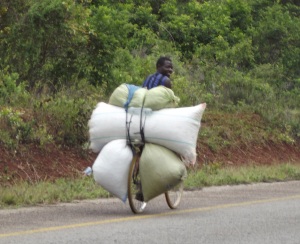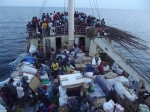I really didn’t expect to be freezing cold in Ethiopia, of all places. On my first few days in Addis Ababa the temperature went below 10 celsius and it rained constantly. I couldn’t handle it – I had to wear all my clothes, sleep in my hoodie and got a head cold. Don’t know how I’m going to survive back in Ireland!
I had chosen Addis as an entry point to Africa because of a cheap promotional flight from Mumbai with Saudi Arabian. $200 for the biggest jump of the trip so far – from the steamy monsoon of Mumbai to the chilly rains of Ethiopia. Otherwise I would have just taken a flight to Nairobi and headed to Malawi from there. But I’m really happy I decided to come to Ethiopia; the country is really beautiful in parts. I spent a month in the North of the country, wandering around some ancient Coptic churches, trekking up to the highest mountain in the country and then driving into the baking Danakil desert to the edge of very active volcanos.
But first I had to learn a bit about the country. I spent the first couple of days visiting the excellent museums of Addis Ababa. Being from Ireland, I’m quite proud of my country’s ancient history going back to the megalithic tombs of Newgrange, but the age of history anywhere in Europe is nothing compared to here. The first exhibit of the first museum I went to was an original 3.5 million year old humanoid skull, found out in the deserts. From there the museum was full of discoveries charting the evolution of mankind, all found in Ethiopia.
Then there were artefacts from the beginnings of Christianity (which came to Ethiopia in the 4th Century, 100 years before most of Europe) and older rock inscriptions that suggest the existence of a Judaic civilization long before that. Other museums were full of stories of the Italian imperial army’s defeat to Ethiopia at the end of the 19th century (the only African army to defeat a European invading force) and pretty shocking collections from the time of the Derg, when Mengitsu armed local militias to kill thousands of dissenting civilians. In the Red Terror museum there are rooms full of skulls of the victims of the cold-war regime, toppled by a group of fighters that included the prime minister Meles Zenawi, who had just died two weeks before I arrived. The country was still in mourning, and every street is still lined with images of the ex-prime minister.
After Addis I got a series of buses for 2 days through the fertile highlands filled with green and gold fields and round huts to Lalibela, an area full of 12th Century churches and tunnels hewn out of solid rock. I had a great day wandering between the churches – which are sunk into the rock rather than dug into a rock face – and getting lost in the labyrinthine tunnels.
The weirdest thing about Lalibela is that at any moment you could come face to face with a skeleton. Ethiopians believe that dying in the vicinity of a church grants you automatic entry to heaven, so many arrange to die in cells peppered around churches. As a result, walking down dark tunnels or entering the compound of a church, I often came face-to-face (or face- to-toe) with skeletons hundreds of years old packed in to small enclaves in the rock.
But the best part of Lalibela was just hanging around the cafes and restaurants. Ethiopia must have the best coffee in the world, and I became addicted to the stuff while I was there. For 10 cents you can have a cup of the best black coffee around or for 20 cents a thick, sweet macchiato. It’s central to the culture here and just walking down the street you can constantly smell it wafting around. I spent most of my time in Lalibela in coffee shops chatting to people. I hung around with the night receptionist from my hotel (BSc Pharmacy), the waiter their friend, a local technical school teacher (BA Education). Most young people in Ethiopia are very well educated but the opportunities for employment are pretty limited, so you meet them on buses and hanging around the towns with little to do.
Next I took more buses North for one and a half days. Journeys in Ethiopia were very long but most of the road system was very good. Chinese contractors are building thousands of kilometres of roads around the country – on any given road construction site you can see a big group of Ethiopian construction workers with picks and shovels labouring away in the hot sun under the supervision of usually one Chinese engineer with a massive straw hat and smartphone. I arrived in Wukro, a one-horse town and entry point to the Tigray region, home to around 80 clifftop churches that date back as far as the 5th century.
I rented a dodgy bike for two days and squeaked my way through the roasting hot countryside to the churches, climbing up the sheer cliffs using centuries-old hand and footholds to the little churches, perched on pretty stunning ledges and caves 100-200m above the plains. When the first Christian monks came here to convert the locals, they found that they got the most respect if they built their churches and monasteries on top of the rocky cliffs that jut out of the scenery. It worked, and the locals stopped worshipping sun and moon gods who lived on top of the hills and nowadays most of them are Coptic christians.

Climbing up to Abuna Yemata Guh, part of which includes walking along a 1m wide path with a large drop on the left.
While in the Gheralta area I stayed in Hawzen, a village infamous for a different reason. In the 80s the Tigray region was full of rebels trying to topple Mengitsu’s regime. In response he waged the ‘red terror’ campaign, killing thousands of people who lived in the rebellious region. One of the worst atrocities of the time was when Mengitsu sent in his Russian planes to bomb Hawzen on market day, when people from miles around converge on the village. Over 2,000 people died. Mengitsu fled Ethiopia when the cold war ended and his military support stopped, and now lives with Bob Mugabe in Zimbabwe. I gave the bike back and took trucks and buses along the very North of Ethiopia, up to the Sudanese border and back to Gonder to join up with some other travelers for a hike. It was market day as we traveled along the roads, which were full of hundreds of camels being driven to market accompanied by herders with AK47s on their backs. The Northern region is fairly volatile and is dotted with refugee camps full of Eritraen and Sudanese refugees. The Ethiopian government has offered all the refugees full citizenship but most of them haven’t taken up the offer, instead prefering to wait in the camps in the hope of gaining asylum to countries such as Sweden or Norway. They seem to have a decent enough quality of life; each camp I saw had a massive UN compound on the edge with WFP feeding tents, UNHCR tents and Medicen Sans Frontiers jeeps driving around.
We hiked for 7 days in the Simien Mountains to Ras Dashen (4500m), the highest mountain in Ethiopia and the 4th highest in Africa. It’s a beautiful wilderness area on the edge of the Northern tip of the Great Rift Valley with endemic species such as the Gelada Baboons that wander around, a special type of Ibex and the Ethiopian wolf.
We hired a donkey, a scout with an AK47 (mandatory for any off-the-beaten-track travel in Ethiopia, it seemed) and a guide and set off into the hills. The hiking was fairly tough but the views were amazing – sheer drops off the edge of the path of up to 2,000m into the plains below. At night we camped in rented tents. I had rented a sleeping bag as well which ended up being a bad choice as it was infested with fleas. After 3 nights of scratching and feeling them hopping all over me I ditched the sleeping bag and wrapped myself in aluminium foil instead – less comfortable but just as warm! We crossed rivers in full flood that nearly washed some of us away, passed kids playing homemade guitars and donkey trains carrying WFP maize up into farms in the mountains.
On the 6th day we reached the summit, up a sharp scramble on an exposed rock face. That evening back at camp we bought a sheep, butchered it and ate almost the whole thing (I accidentally had a chomp on a testicle before spitting it out).
A great thing about Ethiopia was the type of people I traveled with. Most people don’t think of Ethiopia as a travel destination, and the type of traveler that makes it here tend to be quite ‘intrepid’. India had been full of hippies and culture vultures, Nepal had its fair share of no-nonsense hikers and Southeast Asia was full of kids on their first trips abroad. But in Ethiopia I traveled with a mad mix of people – a Tanzanian historian trying to prove links between the Queen of Sheba and the West Arabian Old Jerusalem theory, 2 lawyers who had worked on Charles Taylor’s case at The Hague, a Japanese teenager who had bet his friends that he could travel from Cape Town to Egypt in 60 days by public transport, a Belgian who had worked with the Rwandan government for a year researching renewable energy possibilities and an Israeli student who was tracking down and interviewing Sudanese refugees who had been expelled from Israel earlier this year. Great bunch of travelers.

Hiking with friends at the Jinbar Waterfall.
Noam (Israel), Luke (Ireland), Liam (Ireland), Amelia (USA/UK), Yotam (Israel)
After the Simiens we took a bus journey from hell along an as-yet-unfinished road to Axum, capital of the Axumite kingdom that lasted from the 3rd Century BC to the 7th AD. At its height it was the only civilization apart from the Persians, Romans and Chinese minting their own coins, hosted the prophet Mohammed’s daughter and wife who fled from persecution in Saudi Arabia, and stole the Ark of the Covenant from Israel!
We had a touristy day touring the tombs and visiting the huge stelaes, one of which had been stolen by Mussolini and shipped to Rome, where it stood outside the UN building until 2005, before the Italians finally agreed to fly it home to Ethiopia. The history and stories there would have been enough to fill a week, and the good food and great beer we consumed could have lasted us days, but after a day it was time to move on.
The last trip in Ethiopia was to the Danakil Depression, a huge saline area over 100m below sea level along the border with Eritrea. We went there mainly to visit Erta Ale, one of only 6 continuously erupting volcanos in the world. It’s way out in the desert, 2 days drive from the nearest road. It’s also a very volatile region where Eritraen forces occasionally slip across the border to get up to mischief, and 5 tourists were killedon the volcano crater in January. The Afar people who live in the region are quite warlike, and kids threw stones at our jeeps as we drove past. Because of these things, we hired 2 jeeps for ourselves (8 tourists) and an extra jeep with 3 army guards and 3 local Afar scouts – all with guns.
This area was the stage for the Ethiopian – Eritrean War from 1998 – 2000, when both countries – already dependent on aid – spent 100s of millions of dollars on a pointless border war over an area of arid desert, causing around 100,000 deaths. Our little convoy drove through the arid desert, stopping off at tiny scruffy villages to pay homage to the local chiefs along the way. On the evening of the second day – after the heat of the day had disappated – we climbed up to the volcano crater over sharp lava contorted into weird and wonderful formations.
Standing on the edge of a volcano, looking into the red-hot lava that occasionally flared into 3-4m ‘fountains’, it was hard to believe that it wasn’t going to blow at any moment, entombing us all in lava. Apparently there are tunnels and passageways under the volcano that allows the hot lava to flow away from the crater, enabling a ‘circuit’ of boiling and cooling lava that prevents a major eruption. It was every boy’s dream, standing on the edge of the volcano throwing stones into the lava and playing with our guards’ AK47s. That night we slept on mattresses on the edge of the crater, in the light of the full moon and the glow of the lava, listening to the sound of the ebb and flow of the volcano underneath us. That day was also Dad’s 5th anniversary so it was extra special – I think he’d be pretty intrigued if he knew I was sitting on top of a volcano that night!
We spent the next two days driving around the Dallol area that surrounds the volcanoes. It’s a huge saline area formed when the Red Sea flooded the Danikil Depression. Over thousands of years the water has evapourated and mixed with gases pushing up from the volcanic activity underneath the earth, creating otherwordly chimneys, poisonous pools, brittle terraces and deadly geysers. I got some good recordings of stinky sulphuric gas escaping from one of the psychadelic chimneys in the middle of a pool of water with a PH of around 3. Best to describe it more with a couple of photos:
After the Dallol it was time to leave Ethiopia. It was nearing the end of September and I had only planned to spend 2 weeks there. So I took a series of buses back to Addis – relatively cool and refreshing after the 45 degree heat of the desert – and watched the All-Ireland final two weeks after it happened. It was great to watch Donegal win the Sam for the first time in 20 years, sitting in a hotel lobby stealing their fast wifi and drinking copious amounts of coffee to steady my nerves.
On from Addis it was a four day journey to Nairobi, down the Rift Valley through rich farmland and past lush lakeshores to the border at Moyale and then on through the Northern Kenyan wilderness, full of ostriches, dikdiks, zebras, giraffe and monkeys, dotted with nomadic villages and ubiquitous Chinese road builders toiling in the sweltering heat. I arrived into Nairobi at 5am at Eastleigh (nicknamed ‘Somaliland’), a dodgy area full of lads lurking in the shadows and angry looking graffiti. Luckily I was helped by some friendly ladies on their way to work who showed me the right busline into town from where I walked – covered in sand and mud from the bus journey – past all the smartly dressed people on their way to work in the CBD to my hostel where I stayed washing and recovering for two days. Kenya seemed so developed and efficient after Ethiopia. Nairobi was an exciting city to walk around – not the ‘Nairobbery’ I had been told to expect. Out in the countryside farmers used machinery and grew cash crops rather than the subsistence farming everywhere in Ethiopia (I saw 2 tractors in a month’s travel in Ethiopia; hundreds in Kenya).
Everybody in Kenya speaks great English and were friendly and easy to talk to; in Ethiopia 90% of the conversations I had with people had contained requests for money. I was also pick-pocketed 4 times in Ethiopia, never felt unsafe in Kenya. In Ethiopia as I cycled in the countryside kids had thrown pebbles at me and shouted “YOU YOU GIVE ME MANEY”, in Kenya they waved as I cycled past and said “Hello, how are you?”. In Ethiopia every restaurant bill I received had some extra fake charge on that I then had to haggle about, in Kenya this didn’t exist: many things were easier. I spent three weeks in Kenya. An idea had been growing in my head since India to cycle down the Rift Valley to Malawi. So I bought a bike, a phone and a tent and started out from Kisumu on the shores of Lake Victoria (where I bought the bike).
Armed with a phone and fast internet I was more organized, and contacted cycling organizations and groups around the country before setting off. I also used Couchsurfing for the first time since Korea, and stayed with couchsurfers all over the place. First I visited Buffalo Bikes in Kisumu, a factory that produces extremely strong bikes suitable for African roads and paths. They sell all over Southern, Central and East Africa and also support communities with free bikes in some cases.
From there I headed up to Kakamega, in the heart of sugar cane country. It was quite hilly around there and I found the speed of the slow-moving sugar cane tractors perfect for a bit of ‘surfing’. But I wasn’t the only one grabbing on to the back as they moved up the hill. Kids would appear from the fields and run along beside the trailer, grabbing desperately at the canes to get some free snacks. I have to admit I munched on some myself. Extra energy. I visited the Kakamega forest reserve the next day with Miles (an American couchsurfer and avid cyclist!), walking in to the jungle during the night to watch civet cats hunt and eating a buffet dinner in the nearby colonial-style lodge (the waiters wore dickie-bows). From there it was a long slog up to Iten, the home of long distance running in Kenya. I checked out a cycling club there – Kenyan Riders– who train professionally for big races (they placed 4th in last week’s Tour de Rwanda 2012). I had tea and banana sandwiches with the lads and tried to keep up with them on their morning ride – 70km down the rift valley escarpment and back up a 15km hill to Kabsabet. I managed to keep up with them for all of 3km! My thick MTB wheels and inferior gears held me back, honest! But I caught up with them around 20km down the hill, where two of them had collided and caused a pile up. Teeth had been knocked out, backs bruised, but nothing serious. All in a day’s work.
I stayed for a while by Lake Baringo in the Rift Valley. I camped for the first time 10 metres from the lake. It was an amazing location – hippos grazed in the lake and a rather large crocodile sunned himself around 20m from the door of my tent. The next day I cycled further down the valley along dry and hot roads to Lake Baringo, where I lazed in hot springs all afternoon, ordering cocktails from the bar. And they say travel in Africa is difficult…
Over the next couple of days I made my way back to Nairobi. Cycling in the Rift Valley was very hot, but enjoyable. There were wild animals everywhere. I stopped off at a seasonal lake beside the road for a while and watched hundreds of turtles slouching about in the water as a herd of Zebra drank from the other side. Later I bought wild honey from a lady by the side of the road north of the equator and ate it with some chapatti a kid was selling from a stall south of the equator. The countryside became more lush as I approached Nakuru, and more commercial farms started springing up along the road. Long avenues of trees marked entrances to white-owned ranches and private conservancies.
I spent a couple of days by Lake Naivasha, cycling through Hell’s Gate gorge, created by a massive flow of water millennia ago when a huge lake burst and flowed down the rift valley. Nowadays it’s full of warthog, zebra, hot springs, buffalo, baboons, 5 geothermal power plants and giraffe. I went right down to the bottom of the gorge, where it gets so narrow I had to walk sideways to squeeze through the caverns and then raced a 12 year old English kid to the gates before they closed for the evening. After a week cavorting about Nairobi I was ready to head to Malawi. I had had to change my route. My original plan of cyclingdown to Lake Marigat (you might know it from the movie ‘The Constant Gardener’) and across into Tanzania, past Lake Natron, up to Ol’ Doinio Lengai (an active volcano) and around the edge of the Ngorogoro crater was too adventurous, according to the Tanzanian embassy who wouldn’t give me a visa to cross at that border point.
So I contented myself with a cycle to the Masai Mara and on to Lake Victoria. On my first day I made 156km, the biggest distance so far. I was helped massively by David Kinjah and his Safari Simbazclub. He’s a pro-rider in Nairobi i had made contact with and he’s training up a young team to be the next generation of world beaters. And they’re tough. Riding down the escarpment into the rift valley at 60kms an hour, we overtook trucks and safari jeeps and belted it around the bends. One of the kids took his eye off the road for a second and collided with the guy in front, doing a full flip over his handlebars onto the road. Undeterred, he got back on his bike and kept going. I said goodbye to them at the bottom of the escarpment and headed on to the Masai Mara, another day away on good roads.
I cycled through the Northern area of the Masai Mara, outside the park boundaries. But it was full of herds of buffalo, wilderbeest, gazelle and zebra, with cows being driven by Masai warriors winding past them.
It was a beautiful cycle through classic African scenery along a bumpy dirt road, and I camped that night on the escarpment overlooking the Mara. I woke up before dawn and watched the most amazing sunrise as herds of animals trotted around hundreds of metres below my rocky outcrop. I felt like an extra in ‘The Lion King’. From there I headed on to Migori and on Halloween crossed into Tanzania. Three days later I landed in Mwanza, on the shores of Lake Victoria. I had been camping out for a long time, and had been washed out one night when I chose a low camping spot that got flooded during the night (I woke up puzzled at how I had acquired a waterbed), so it felt amazing to be sleeping in a proper bed again and dry out all my stuff. I stayed with Feng Tingkai, one of the million or so Chinese entrepreneurs working in Africa.
He’s developing a satellite TV company in Western Tanzania – Startimes – providing decent subscriptions at a fraction of the price of DSTV, the South African owned competitor. Mwanza was a nice town to relax in for a couple of days – crumbling colonial buildings, a busy port, a forgotten railway line that has found a new life as a fish market, and a really good Chinese restaurant with Sichuanese chefs! I biked out of Mwanza finally on the 6th November, well fed and rested. From there it was 5 days to Kigoma, along the southern shore of Lake Victoria past the gold mines at Geita and on through the bush, turning South near the Rwanda border at Biharamulo to Nakanyazi and on South along the Burundi border to Kigoma. I found the cycling relatively easy compared to India. It was relatively flat (if you call 3km gradual climbs followed by 3km gradual downhills flat) and the weather mostly behaved itself (apart from the occasional downpour, when I put on my ridiculous superman-style plastic poncho and pedalled on).
Cycling in East Africa is pretty repetitive. The scenery doesn’t really change: forests occasionally give way to scrubby maize fields cut out of the bush fronted by a well-swept mud hut compound with 7 kids playing around it, a man sitting in the shade checking his mobile phone and his wife washing clothes, preparing dinner, feeding the baby and pounding maize all at one time. “Mzungu wa bisakelli, wayway?! Ah ah AAAH!” (“A white man on a bike, why why?! Ah ah aaah”). Then the villages: all exactly the same. Two rows of mud huts with tin rooves front on to the road. The population is ever fluctuating: people walk to the village to drink tea and catch up on gossip and buy a miniscule blue plastic bag of salt or a single cigarette before walking back into the bush to their farms. I usually took an hour’s lunch break and sat watching the world go by. A truck or bus would arrive in a cloud of dust and suddenly the village is a frenzy of activity – a month’s produce of onions, mangos, firewood, charcoal or potatoes is offered on outstretched hands or in tubs expertly balanced on the seller’s heads.
Every village in Africa has a speciality – one will produce very good red onions while 3km down the road you’ll find everyone selling good quality toothpicks. There’s no diversity – usually only 3 or 4 types of local produce will be for sale. The truck revs up needlessly for a couple of minutes and then hurtles off, and the village settles with the dust. A crazy man with matted hair and bloodshot eyes (every village has one) wanders around in filthy rags, shouting abuse at everyone. People shout abuse back, then chuckle and give him food and beer to placate him. In the restaurant on the side of the road I’m usually sweating at a too-small table still wearing my helmet and eating a delicious meal of rice or ugali and goat meat (boiled vegetables if I’m lucky). The waitresses always insist I wash my hands in filthy brown water with a bar of laundry soap, then fills up my teacup with too-sweet spicy tea.
The kids amble around in their starched school uniforms with their schoolbooks. It’s 11am but there’s no need to actually go to school – the teachers are all sweating in the shade of the mango tree in the street checking their phones and conducting business (their salary of $70 per month isn’t enough to support their own family so they spend their time trying to make money on the side). But it was enjoyable – Africa is a continent of cyclists so I was never really alone. I’d be accompanied for a couple of kilometers every couple of hours by lads carrying huge loads of charcoal from the bush to the next market town or passed out by cheering bike taxi men with a chortling African mama on the back, weighing in at around 90kgs. Everyone rides ‘Black Mambas’, single speed Indian-made bikes that last forever and every time i stop men crowd around my bike, marvelling at the gear system and disk brakes. The only bad experience I had in 3 weeks cycling was being slide tackled by one of the aforementioned ‘village crazy men’ in SW Kenya, who ran from a roadside bar and took out me and the bike with a premiership – worthy 3 metre slide tackle. We both landed in a heap in the dust, luckily uninjured. As I picked up my bike and straightened the handlebars he did push-ups in the street in front of me and then stood up bellowing and approached me again. I threw a pebble at him and he scarpered. The whole village fell about laughing.
I reached Kigoma – the end of the road on the shores of Lake Tanganyika – for the weekend after a long long ride, and waited there for a week to catch a ferry down the lake. I stayed with Insun, a Korean volunteer teaching physics at the local secondary school, teaching Taekwondo in his garden and cultivating a lush garden of crops for his very productive kitchen.
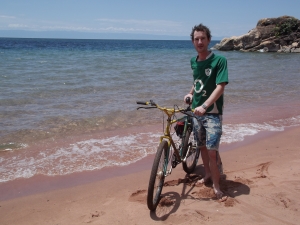
Scruffy Irish Cyclist Reaches Shores of Lake Tanganyika. Washes Properly For The First Time In Weeks.
We went camping by the lake that weekend and I swam actively for the first time since Thailand. We set up tent on the beach, barbequed up some tender goat and fended off the monkeys when they tried to steal the mangos and bananas. On Monday he headed off to work and I explored the town. Kigoma is the end of the road and railway from the coast and feels like it. In the distance across the lake were the mountains of Congo with permenant thunder clouds hanging over them. Fronting on to the lake is a busy port with a large ship docked loading equipment for a prospecting voyage around the lake. Other boats were shipping goods up to Burundi and at night the lake lit up with fishermen fishing using spotlights to attract the fish. I cycled around the sleepy town eating endless snacks and drinking fresh passion fruit and mango juice before catching the MV Liemba on the 14th November.
The MV Liembawas built in Germany in 1913 and sailed to Dar Es Salaam, where it was taken apart and transported by the newly built railway line across the country. By the time it arrived World War 1 had broken out and it was fitted with guns to fight the British and Belgians on the lake. It’s a long story but basically it was purposefully sunk and lay at the bottom of the lake for 9 years before being resurfaced and has chugged up and down it ever since.
Nowadays it ferries people and goods up and down Tanganyika from Kigoma to Zambia and back. I got myself into a tiny 1st class cabin and tied the bike up on deck and for the next 3 days sailed down the lake. There was a great bar on the boat and good food, and I got tours of the engine room and could drop in to the bridge to hang out with Captain Titus Benjamin whenever I wanted. There were other travelers on the boat too – a German social worker, Austrian architect and English sculptor. We spent a lot of time up on the roof of the ship watching sunsets and sunrises among the drying piles of fish.
Every time we stopped at one of the little fishing villages a frenzy of canoes and boats would surround the boat and start trading with the passengers. Fish, pineapples, baskets, roofing wood were all thrown on and off the boat as prices were agreed or disagreed on. Passengers disembarking at the villages also had to jump off the Liemba onto little canoes to make their way back to the villages and I saw more than one baby slung unceremoniously over the side and down into a canoe. We passed some ultra-luxurious wilderness lodges along the way too: Mahale Mountains national park had a forest lodge Bill Gates hangs out in and further south near Kipili is a $2000-per-night island where Arnold Schwarzenegger apparently spent his holidays last year. This all contrasts ridiculously with the people making their way up and down the lake in their canoes, but such are the paradoxes of Africa.
After leaving the Liemba at Kasanga we stayed at Oscar’s place for 3 days. He had made his money trading fish with Congolese and bringing back gold to Tanzania in his boat and had beached it in Kasanga, built a bar and some chalets and set up a tourist camp. Great guy.
We rented his boat out and sped down incognito into Zambia for a day to climb to Kalambo Falls, the 2nd highest waterfall in Africa. It was a great day, but a bit uneasy when we almost ran out of fuel on the way back, being chased by a huge electric storm coming across the lake from Congo. And finally it was up to Mbeya from Kasanga. I had wanted to link up with a Dutch cyclist on his way to Cape Town from the North Cape of Norway, so put the bike on top of the bus instead of cycling (which would have taken 3-4 days). 18 hours after leaving Kasanga we met up in Mbeya. After a day’s rest sipping juices and fixing up the bike a bit in Mbeya (the gear cables had snapped, of all things) myself and Gijs set off for Malawi.

Gijs cycling along Lake Malawi. He had just passed his 15,000km mark, I had just passed my 1,500km mark! We celebrated with beers on the beach. http://www.capetocape2012.com/
He’s riding an electric bike, which gives a little boost when the batteries are plugged in. He’s also got narrow tyres and is much fitter than me. But he’s carrying 70kgs and I only have around 25 so we even out in most things. We’ve tried swapping bikes and we still can keep up with each other.
We made it across the Malawi border in one day from Mbeya, up through pretty tea and coffee plantations, camping in a chief’s compound on the Malawi side. On the second day we cruised along the lake, looking out at the beautiful Lake of Stars I last saw 6 years ago. We parted ways in Chitimba, he to Mzuzu and myself up to my current position at a permaculture farm near Livingstonia.I’ve been here 3 days swimming in the nearby waterfalls, hiking up to see the 104 year old hydroelectric system on the nearby hill, having a barbeque and helping out a bit in the gardens. Auke – a Congolese-Belgian who has been here since 1995 – is an avid cyclist and i’ve already agreed to sell him the bike after I finish. He’s given me lots of ideas of places in Malawi to cycle, and I’m already ready to head off again into the Malawian bush.
It’s good to be back.








